
The Wanzenried Manufactory during the Loder & Schweizer period (1919-1925), 1925-1961 Adolf Schweizer, art pottery.
Pottery made by Adolf Schweizer in CERAMICA CH
Andreas Heege, Andreas Kistler, Margret Loder 2021
Adolf Schweizer was born on 4th November 1893 in the Glockenthal area near Steffisburg and died on 1st December 1967. His grandfather Johannes (1837-1879) was a carpenter. His father Johannes (1864-1901) was a factory worker (Täglicher Anzeiger für Thun und das Berner Oberland, 2/12/1893; family tree). Having finished school, Adolf completed an apprenticeship as a potter at the Wanzenried Manufactory (probably around 1908-1911) and attended the pottery school in Steffisburg.


Two designs by Adolf Schweizer, Steffisburg Pottery School (today SST 14701).
He subsequently attended the School of Ceramics in Bern, enrolling in the summer of 1911 and graduating in the summer of 1915 (student work 1911-1915).
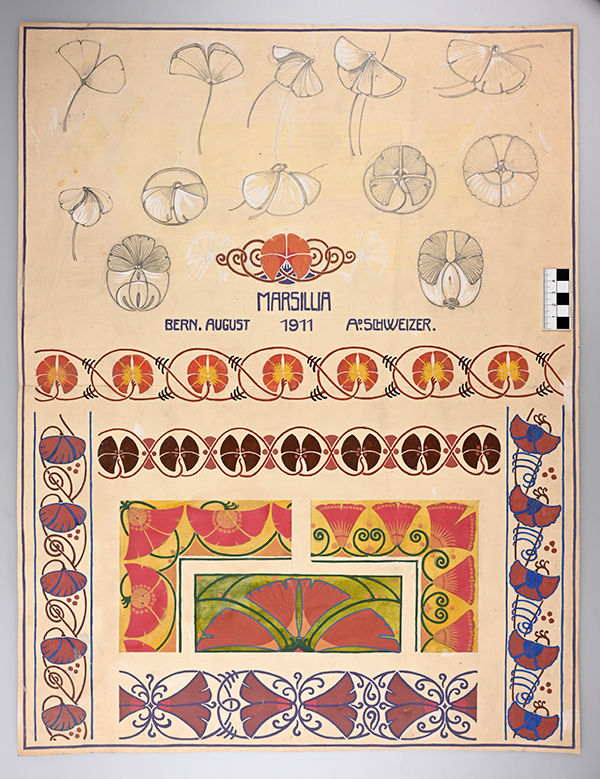
Pattern sketch by Adolf Schweizer, 1911 (from the Kunstkeramik Luzern company archive, today in the State Archive of Lucerne).
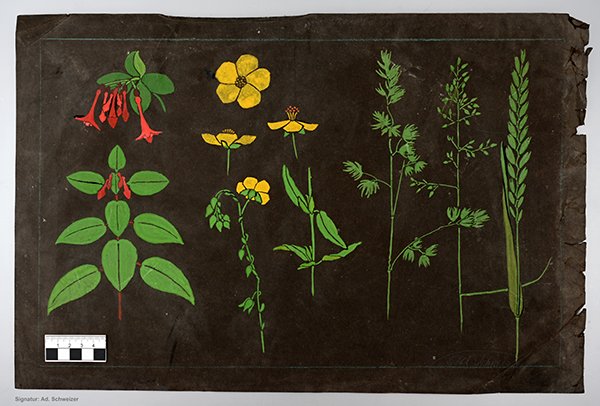
Botanical study by Adolf Schweizer, between 1911 and 1915 (from the Kunstkeramik Luzern company archive, today in the State Archive of Lucerne).

Stylisation study by Adolf Schweizer, 1912 (today SST 14701).

Ceramic design by Adolf Schweizer, 1912 (today SST 14701).

Ceramic design by Adolf Schweizer, 1915 (today SST 14701).
After graduating in Bern, Adolf Schweizer became the managing director of the newly formed DESA cooperative.
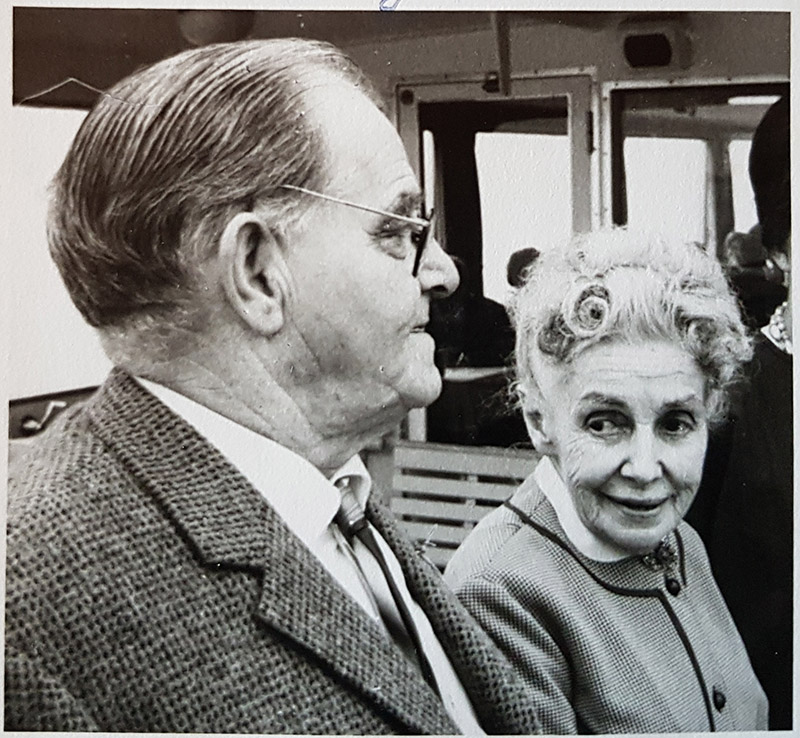
Adolf Schweizer and Elise Eyer in later years (photo in private ownership, Schweizer family).
In 1917, Adolf Schweizer married Elise Eyer (1892–1970, daughter of potter Gottfried Eyer, 1856–1892 and his wife, Elise Gfeller; Oberländer Tagblatt dated 9/11/1917), who worked at the Wanzenried Manufactory as a pottery paintress. The couple had two sons and a daughter (all information from his obituary in the Thuner Tagblatt 91, 1967, No. 288). One son, Hans (1919-1988), also became a potter.
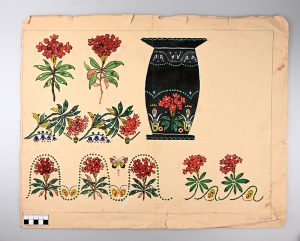
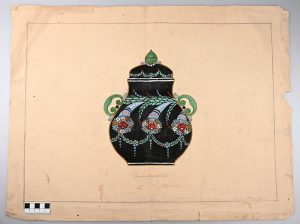
Pottery and decoration designs by Elise Eyer, either for the Wanzenried Manufactory or for Loder & Schweizer, prior to 1925 (from the Kunstkeramik Luzern company archive, today in the State Archive of Lucerne).
As none of the student lists from after 1906 have survived, we can only assume that Elise Eyer trained as a pottery paintress at the potters’ school in Steffisburg. The company archive of Kunstkeramik Luzern contains various signed design sketches that attest to Elise Eyer’s skill in drawing and graphic design.
We know that on 11th December 1918 Adolf Schweizer and Emil Loder (1890–1971) jointly purchased the manufactory from the widow Wanzenried for the sum of 18,000 Swiss francs (15,000 francs of which came in the form of a promissory note) and took over the company including its assets and liabilities from 2nd April 1919 (land register GB Thun, Beleg II, 775 17/3/1919). The founding of their partnership on 1st March 1919 was announced in the Swiss Official Gazette of Commerce (SOGC 37, No. 59, 8th March 1919). Emil Loder had probably been the managing director of the manufactory since the end of 1915. We can only speculate that the two had met socially in Steffisburg or had perhaps known each other from before.
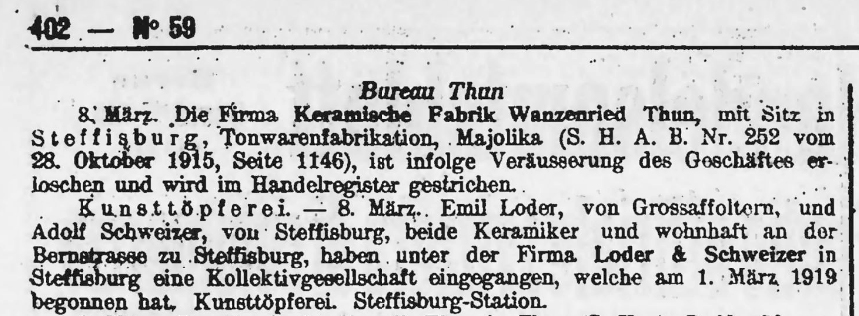
Announcement of the partnership published in the Swiss Official Gazette of Commerce in 1919.
The Wanzenried Manufactory became (advertisement dated 1922):
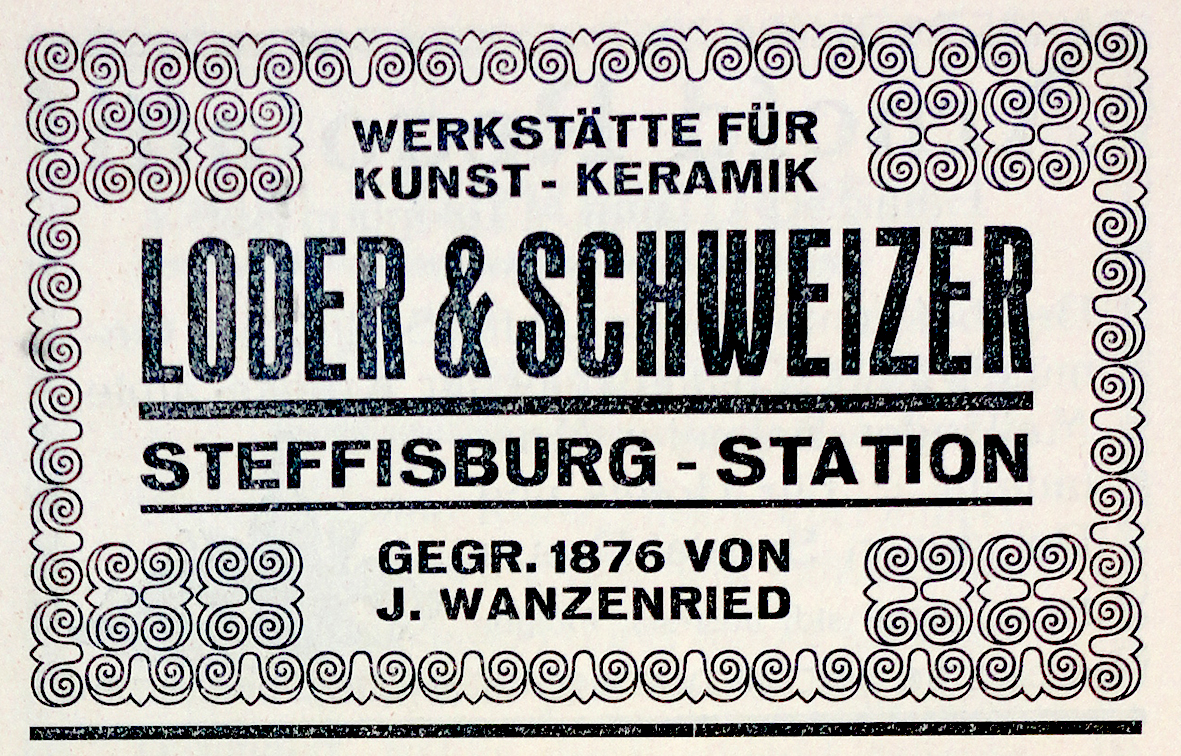
(Note: The founding date of 1876 is incorrect! The Wanzenried Manufactory was founded in September 1878).
A photo album in Emil Loder’s estate (now in the State Archive of Lucerne, PA 1421/PLA 202, Kunstkeramik Luzern company archive) bears witness to products from their joint venture. Loder & Schweizer continued to produce some of the successful patterns and ranges of ceramic wares that had been introduced by the Wanzenried Manufactory, including the Alt-Thun/Chrutmuster pattern and an earthenware production line with slip-trailing and incised decoration.
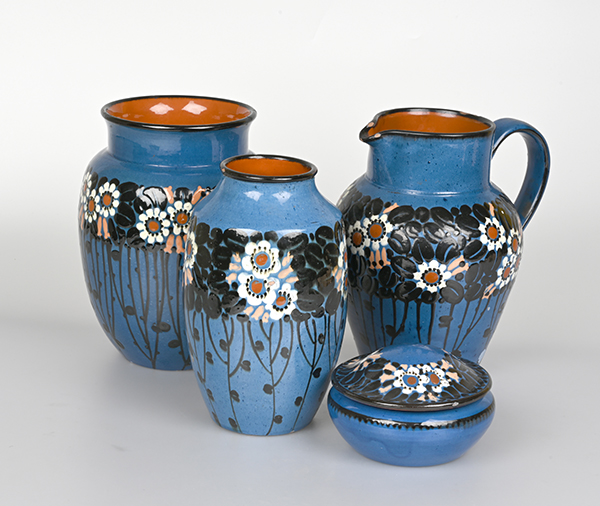
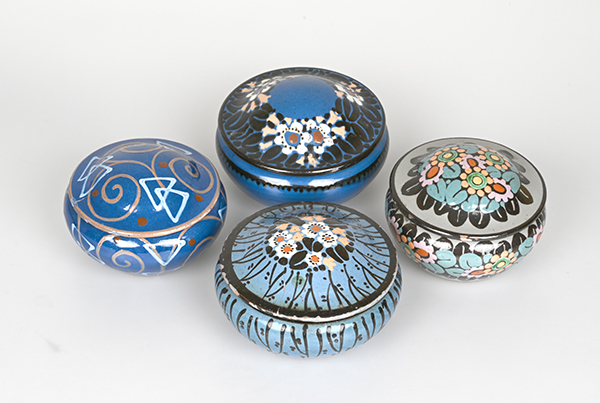
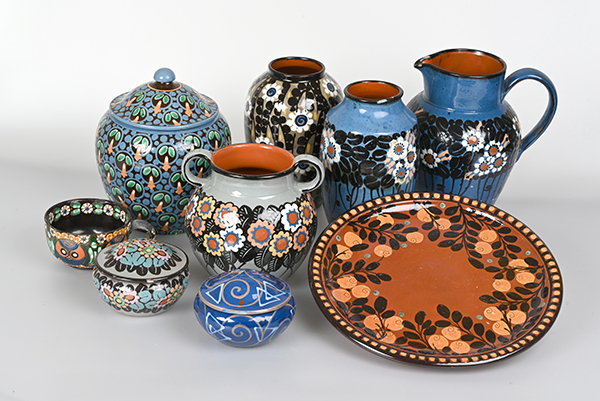
Pottery made by Loder & Schweizer in private ownership and in the collection of the Thun Castle Foundation.
At the same time, numerous new shapes and decorations were developed, no doubt mainly by Emil Loder, who numbered each design. Stylistically, his decorative motifs would be considered to be Late Art Nouveau or Art Deco.
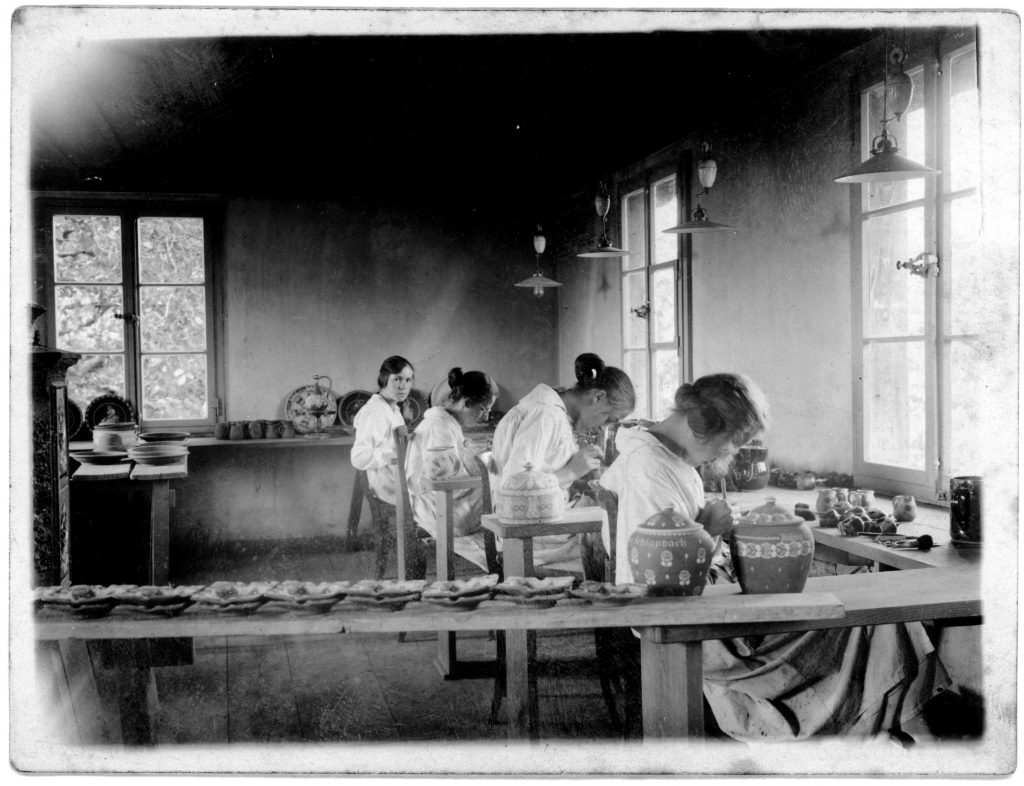
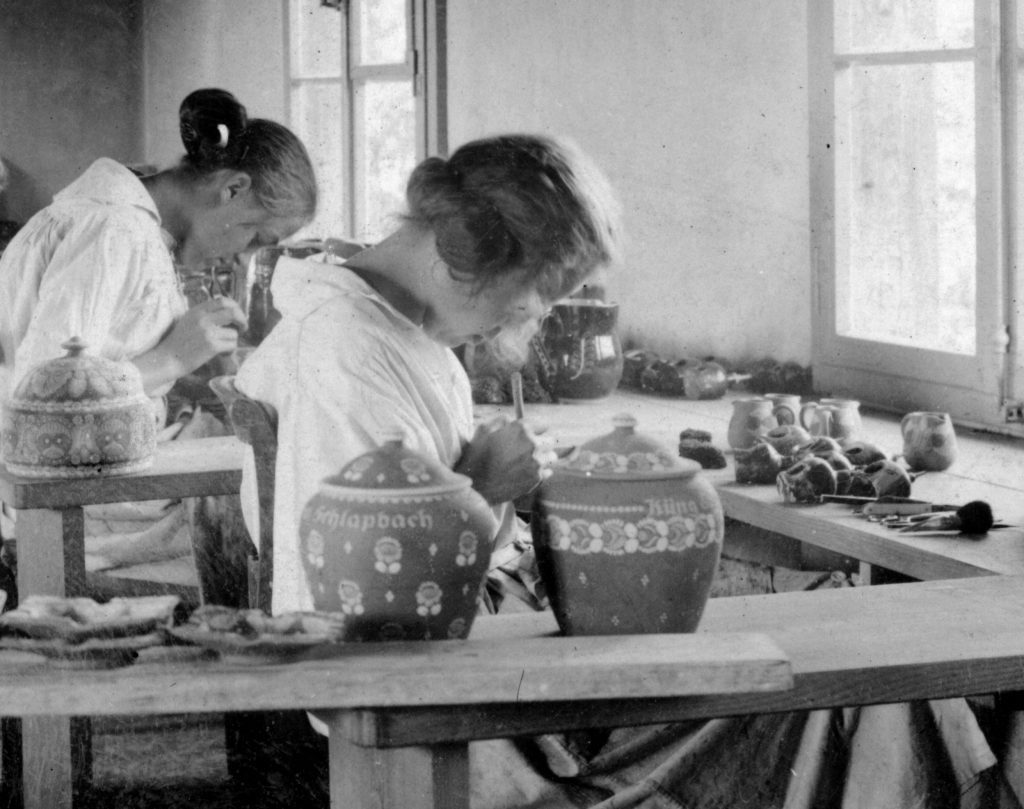
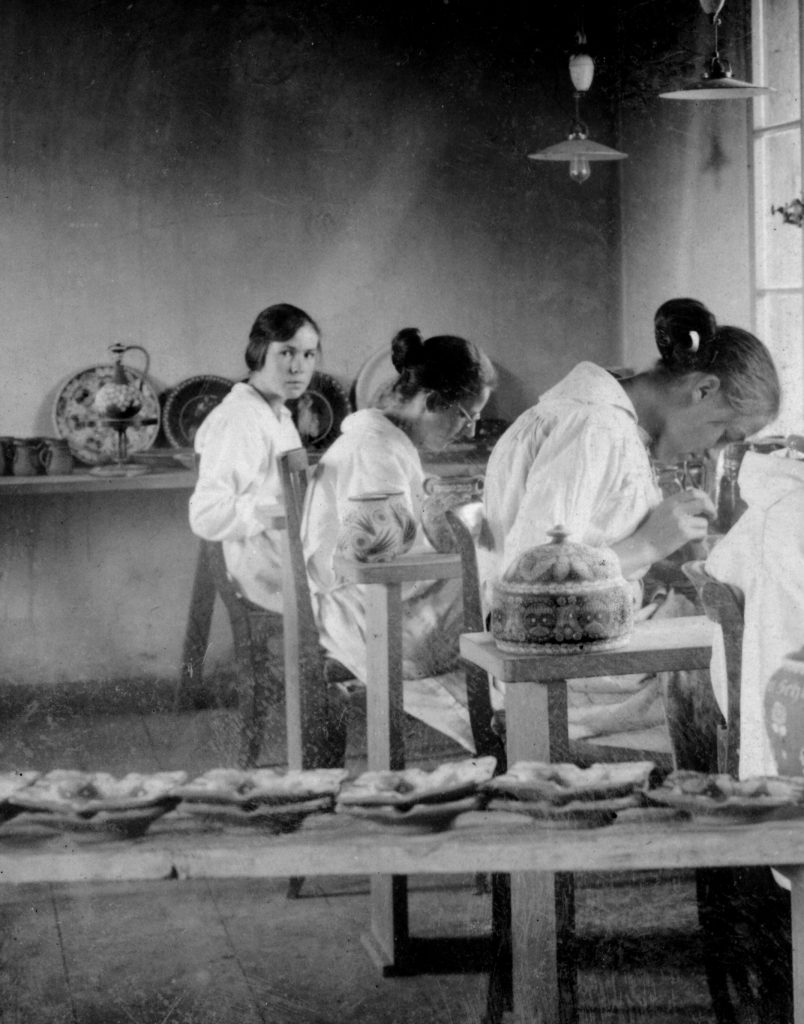
Painting shop at Loder & Schweizer, c. 1919-1925 (photo from the Kunstkeramik Luzern company archive, today in the State Archive of Lucerne).
In 1919, six men and one woman appear to have been employed at the Loder & Schweizer workshop (Frank 2000, 580 based on RSA Thun B 118).
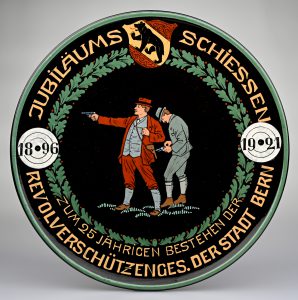
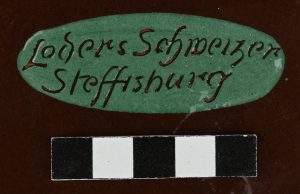
Ceramic designs by Paul Wyss were used regularly (an identical dish can also be found at the Swiss National Museum, LM-119721).
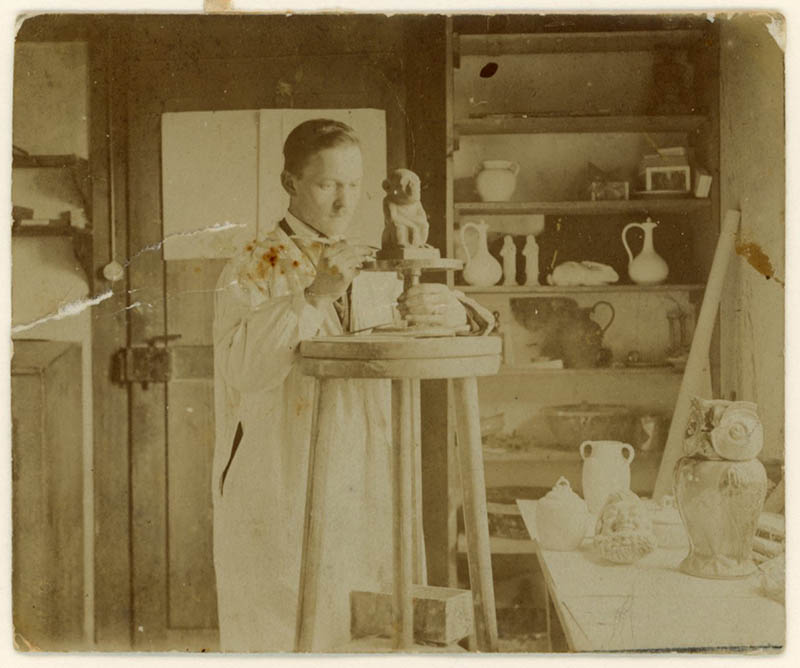
Emil Loder also turned his hand to sculpting and produced various animal figures for the manufactory (photo from the Kunstkeramik Luzern company archive, today in the State Archive of Lucerne).
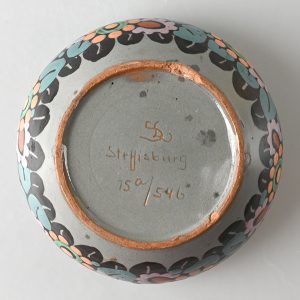
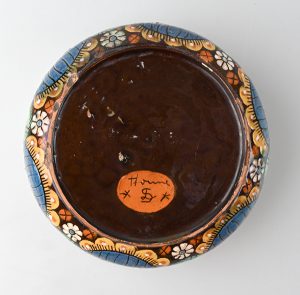
Pottery made by Loder & Schweizer in private ownership and in the collection of the Thun Castle Foundation.
The manufactory mark was a ligature logo “LS” (Loder & Schweizer), which was often combined with the placename Steffisburg and the shape or decoration number. Vessels decorated with the “Alt-Thun” pattern, however, still bore the two stars from the Wanzenried Manufactory and the placename “Thoune”.

Sales were partially generated via the Mustermesse fair in Basel, which had been founded in 1917 and at which Loder & Schweizer are known to have exhibited from 1920 to 1924 (Official catalogue of the Mustermesse Basel, 1920-1924). Shown here is the invitation by Loder & Schweizer to its customers to attend MUBA 1924.

From the correspondence between Emil Loder and his future wife Frieda Schenk we know that, in early 1925, Emil Loder and Adolf Schweizer decided to dissolve their partnership due to a dispute. What led to the dispute is not known, but it did not stop the former colleagues in subsequent years from taking on major contracts together, for example for the 1939 Federal Shooting Festival in Lucerne. Adolf Schweizer acquired the company in 1925 and Emil Loder moved to Lucerne, where he set up the company Luzerner Keramik.
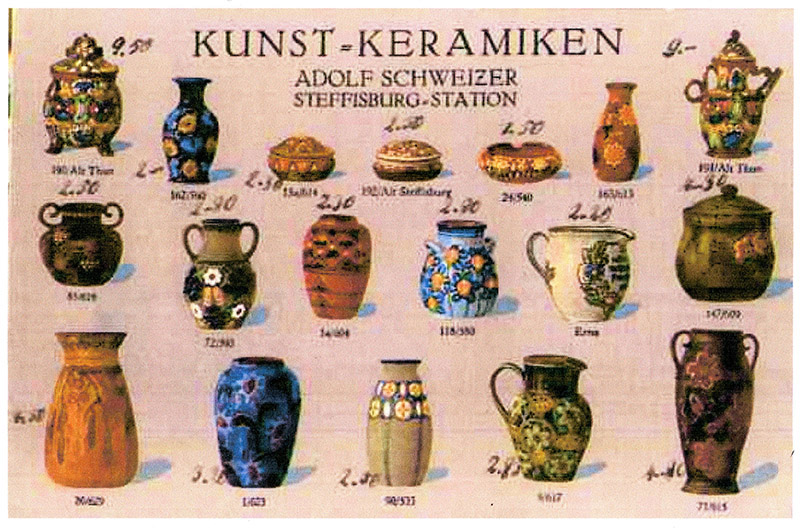
Advertising flyer for the company Adolf Schweizer (photocopy from the Kunstkeramik Luzern company archive, today in the State Archive of Lucerne).
Adolf Schweizer continued to run the business together with his wife until 1961. In the beginning, the style of the pottery they produced was the same as the Loder & Schweizer wares and the “Old Thun” decorations were also retained.
Adolf Schweizer was one of the founders of the Swiss Association of Master Potters and became its first president in 1921 (Illustrierte Schweizerische Handwerker Zeitung No. 25, 1921, 258).
In November 1925, the Schweizers were awarded second prize for their pottery at the 6th competition run by the Swiss Heritage Society, with the ceramicist Hanni Nencki taking first prize (Der Bund, 76, No. 476, 8th November 1925). On display at the 1925 Christmas Exhibition of the Schweizerischer Werkbund at the Museum of Applied Arts in Bern, the Schweizers’“beautifully decorated ceramics” were favourably reviewed (Der Bund 76, No. 530, 12/12/1925). From 1925 to 1931 and again from 1943, Adolf Schweizer had a stand at MUBA (a fair in Basel) (official MUBA catalogues from the Swiss Economic Archives in Basel).
In 1926, Adolf Schweizer also took part in the Christmas Exhibition of the Bern division of the Schweizerischer Werkbund at the Museum of Applied Arts in Bern (Das Werk 13, 1926, XXIII).
In 1927, Adolf Schweizer participated in the “Swiss Week” Exhibition at the Museum of Applied Arts in Bern, exhibiting “attractive and extraordinarily well-made vases, bowls and jugs” (Neue Berner Zeitung 25/1/1927, StAB BB 1.9.34, Zeitungsausschnitte).




Also in 1927, he displayed his wares at a Swiss pottery exhibition in Geneva (“Céramiques Suisses”). The exhibition catalogue contained two photographs of that year’s products, which are almost never found in museum collections today. In an advertisement, Schweizer stated that he specialised in art pottery of the “Vieux Thoune et Mosaïque” (Old Thun and Mosaic) style. The latter was a new type of pattern that derived from the “Chrutmuster” or “Old Thun” style, and whose incised mark included the label “Mosaïque”.
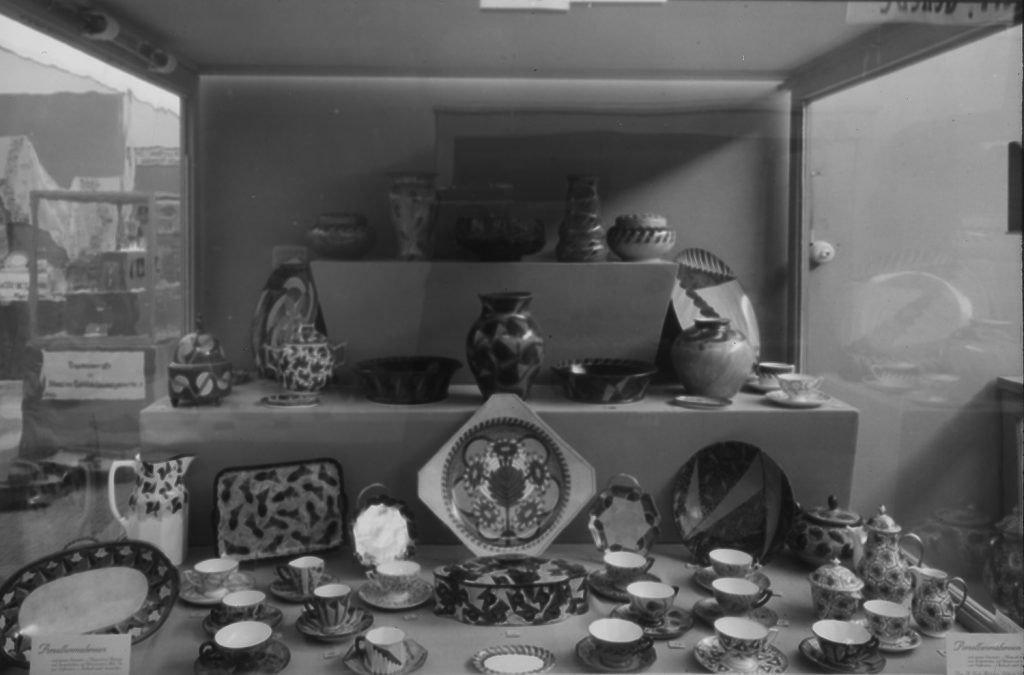
A showcase of pottery at Saffa (Swiss Exhibition of Women’s Work) in 1928 (Source: State Archive of the Canton of Bern, V Frauenzentrale 129).
In 1928, the Adolf Schweizer company was also represented at “Saffa“, as was DESA, exhibiting “women’s work in art pottery” (Oberländer Tagblatt 52, No. 225, 25/9/1928).
Also in 1928, Adolf Schweizer extended his workshop by adding a timber-framed storage space measuring 5.1 m by 6.6 m with a flat tin roof. A year later, he reactivated the hydropower system that was already present on the site and built a water wheel with 5.5 horsepower (Frank 2000, 575).
Even before 1928, Adolf Schweizer had become a member of the supervisory board of the Museum of Applied Arts in Bern (Der Bund 80, No. 387, 21/8/1929). He also became president of the “Kunstgewerbliche Hand- und Heimarbeit im Berner Oberland” (Society of Crafts and Cottage Industry Workers in the Bernese Oberland region) which had been established on 5th March 1928 (SHAB 46, 1928, No. 108, S. 919).
During “Swiss Week” in 1929, Adolf Schweizer staged an exhibition in the Freienhof in Thun (Oberländer Tagblatt 53, No. 252, 28/10/1929). He was the only ceramicist, besides the Langenthal porcelain factory, to be included the “Exportmusterlager des Kantons Bern” (a store of export samples from various businesses in the Canton of Bern) in 1930 (Der Bund 81, No. 278, 19/6/1930).
In 1930, Adolf Schweizer exhibited his wares at an exhibition entitled “Oberländische Volkskunst” (folk art from the Oberland region) at the Museum of Applied Arts in Bern (Berner Tagblatt 23/10/1930, StAB BB 1.9.34, Zeitungsausschnitte). Another exhibitor was the company “Lanz Brothers Pottery” from Thun (Neue Berner Zeitung 3/11/1930, StAB BB 1.9.34, Zeitungsausschnitte).
In 1931, he became the founding president of the “Verkaufsgenossenschaft für Heimarbeitsartikel” (Oberländer Heimatwerk), a sales cooperative on Bärenplatz square in Bern, which was set up to promote the sales of cottage industry products (Der Bund 82, No. 404, 1st September 1931; see also SOGC 49, 1931, No. 268, p. 2446).
From 29th December 1933, Adolf Schweizer also served as president of the Bernese Association of Master Potters (SOGC 52, 1934, 60), which he had helped to establish in 1916, and held that position for several years (Der Bund 86, No. 503, 28th October 1935, report on the Chachelimärit, a pottery fair held at the Museum of Applied Arts; see also Thuner Tagblatt 90, No. 196, 23/8/1966). Many of the members of the Association of Master Potters were represented at MUBA in 1921 (official catalogue of the fair, 1921). In March 1933, the association was granted planning permission to build an extension to Adolf Schweizer’s workshop which would house their clay preparation equipment. The extension was stone-built and had a tiled roof (Frank 2000, 575). The measure did not prove successful, however, and in 1938, the machinery was sold to the Kohler workshop in Schüpbach. Adolf Schweizer later installed his own ball mill, which remained in operation until 1965 (Frank 2000, 773).
In 1934, he participated in the grand “Chachelimärit” pottery fair at the Museum of Applied Arts in Bern (Der BUND 1/11/1934, StAB BB 1.9.34, Zeitungsausschnitte).
In 1936, Adolf Schweizer, together with the ceramicist Adolf Schmalz and the master potter Jakob Reusser, gave a talk on Heimberg pottery and its history at the Arts Society in Thun (Oberländer Tagblatt 60, No. 136, 13/6/1931). Of course, the 1936 Steffa – the Steffisburg Exhibition of Trade, Crafts and Industry – could not be held without Adolf Schweizer. He was a member of the organising committee and also had is own stand at the exhibition itself (Oberländer Tagblatt 60, No. 171, 24/7/1936).


Aided by a group of unemployed people, he produced the ceramic admission passes to the Steffa exhibition at his workshop.
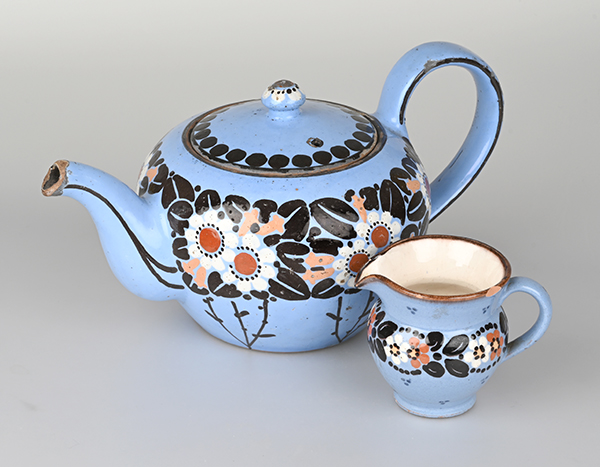
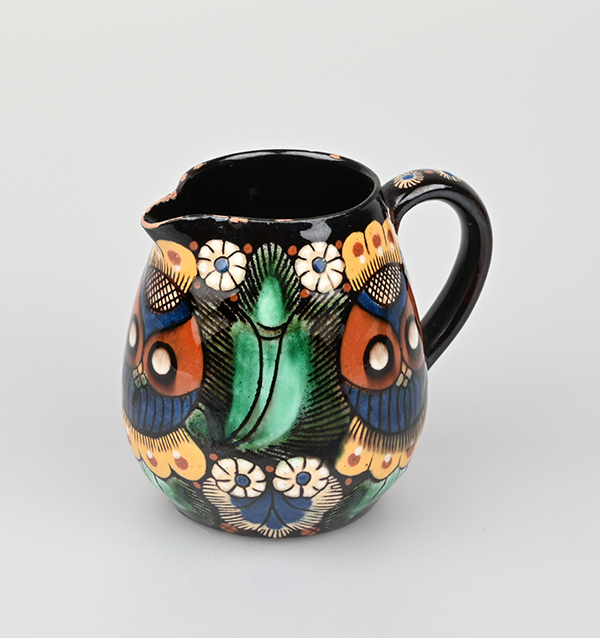
Pottery made by Adolf Schweizer in private collections.
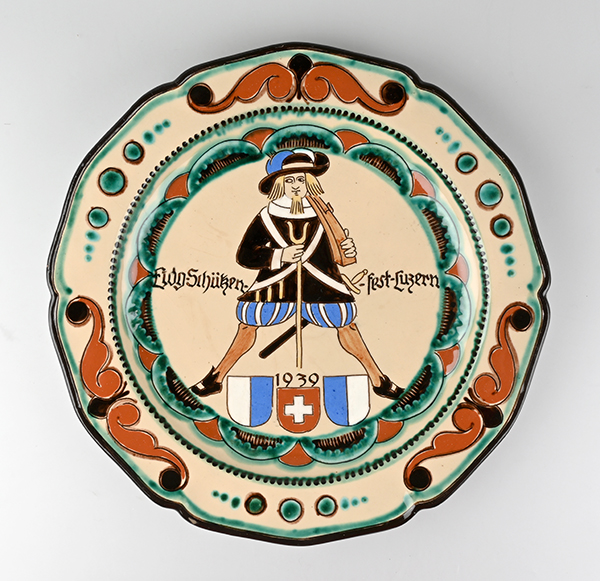
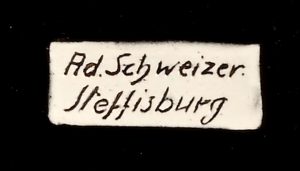
Plate for the Lucerne Shooting Festival in 1939 (with thanks to Angelo Steccanella for the suggestion; identical pieces can be found at the SNM [LM-81440] and at the HMLU [13865.560]).
We do not have a comprehensive overview of every product made by Adolf Schweizer’s company from 1925 to 1962. It is possible that images of the company’s MUBA stands, which probably exist, would provide some assistance in this regard. We know from newspaper reports that he definitely participated in 1928 (Oberländer Tagblatt 52, No. 92 dated 30/4/1928). A 1954 report on MUBA claimed that Adolf Schweizer had been a regular exhibitor for more than 24 years at that stage (Oberländer Tagblatt 78, No. 108, 11/5/1954). Another mention dates from 1964 (Thuner Tagblatt 88, No. 49, 28/2/1964).

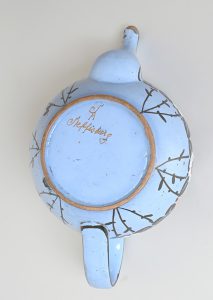
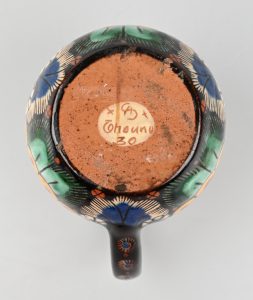
Pottery made by Adolf Schweizer in private collections.
Adolf Schweizer used a ligature signature consisting of the letters “SA”, often with the addition of “Steffisburg”. Like the Wanzenried Manufactory, he too marked his “Old Thun” patterns with a star on either side and the placename “Thoune”.


In the 1930s, Adolf Schweizer appears to have had a small production line of faience, much like Emil Loder in Lucerne.
1961 he moved his business to 21 Bernstrasse in Steffisburg and set up another small workshop, where he, together with his wife and son produced ceramic wares until at least 1967 (Thuner Tagblatt 87, No. 258, 4/11/1963). His son Hans continued to run the art pottery workshop at the same address until 1988 (SOGC 87, 1969, No. 70, p. 657). It is often difficult to distinguish between his mark (“HS”) and his father’s (“AS”).
Because of the sale of the workshop (including all assets and liabilities as per 1st May 1961), Adolf Schweizer’s descendants have practically no archival records.
In 1961 the business was sold to Hans Schneider-Kraft, master potter from Seftigen (1923-2006) and his wife, Susi Schneider-Kraft. Hans Schneider completely renovated and modernised the business (Thuner Tagblatt 86, No. 275, 23rd November 1962; see also the land register, GB Thun, Bel. 6, No. 7226, dated 16th October 1961). In 1965, he dismantled the old clay preparation equipment, which was far too large for the business and not economically viable (Frank 2000, 575, 578).

1991 alterations: Thuner Tagblatt, Volume 115, No. 38, 15th February 1991

Thuner Tagblatt 115, No. 77, 4/4/1991
Further extensive renovation work was carried out on the buildings of Johann Wanzenried’s former majolica factory from 1989 to 1992 (Thuner Tagblatt, Volume 115, No. 38, 15th February 1991; Thuner Tagblatt 115, No. 77, 4/4/1991, cf. also Frank 2000, 575).
Hans Schneider continued to manufacture pottery until at least 1996. He exhibited his ceramics at the 1994 trade exhibition in Steffisburg (Thuner Tagblatt, Volume 120, No. 95, 24th April 1996). It is not clear exactly when the business closed down.
Pottery made by Adolf Schweizer on Antik und Rar
Pottery made by Hans Schweizer on Antik und Rar
Pottery in the collection of the SNM
Pottery in the collection of the MAG
Translation Sandy Haemmerle
References:
Frank 2000
Georg Frank, “Dank dem Gewerbefleiss früherer Jahrhunderte”. Die Nutzung der Wasserkraft in der bernischen Gemeinde Steffisburg vom ausgehenden 13. Jahrhundert bis zur Gegenwart, Thun 2000, bes. Kap. 4.16.

